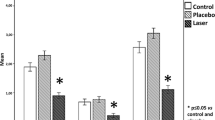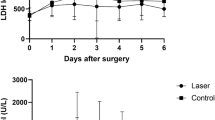Abstract
Myocardial revascularization surgery (CABG) is the most appropriate treatment for coronary artery disease. Currently, the great challenge is to reduce postoperative complications, such as wound infections, dehiscence, pain, and patients’ quality of life. The saphenectomy is the target of complications in 10% of cases, which can cause greater morbidity, time, and cost of hospitalization. Studies show that low-intensity laser or light-emitted diode (LED) therapy promotes positive biomodulation of the tissue repair process, culminating in a lower incidence of dehiscence, pain reduction, and improvement in quality of life. The objective of the present study was to evaluate clinically the saphenous tissue repair after LED therapy. Forty subjects of both genders who underwent CABG with extracorporeal circulation were randomly divided into two groups: the placebo (PG) and experimental (EG). The experimental group underwent low-intensity LED therapy (λ 640 ± 20 nm, 6 J/cm2) on saphenectomy. The tissue repair was analyzed by digital photogrammetry on the first and fifth postoperative day. The border closure was blindly evaluated by three researchers. The hematoma and hyperemia area was quantitatively analyzed using ImageJ© software. The results showed that in the experimental group, there were less bleeding points and no dehiscence in saphenectomy, as compared to the placebo group. There was also a smaller area of hematoma and hyperemia in the experimental group (p < 0.0009). These data lead to the conclusion that the type of phototherapy protocol employed can assist in tissue repair.


Similar content being viewed by others
References
Ferreira-González I (2014) The epidemiology of coronary heart disease. Rev Esp Cardiol (Engl Ed) 67:139–144. https://doi.org/10.1016/j.rec.2013.10.002
Pinto NC, Pereira MHC, Tomimura S et al (2014) Low-level laser therapy prevents prodromal signal complications on saphenectomy post myocardial revascularization. Photomed Laser Surg 32:330–335. https://doi.org/10.1089/pho.2013.3503
de Oliveira EL, Westphal GA, Mastroeni MF (2012) Características clínico-demográficas de pacientes submetidos a cirurgia de revascularização do miocárdio e sua relação com a mortalidade. Rev Bras Cir Cardiovasc 27:52–60. https://doi.org/10.5935/1678-9741.20120009
Payró Hernández LE, Carmona Jarquín GA, Careaga Reyna G, Zaldívar Cervera JA (2012) Complicaciones de safenectomía en pacientes sometidos a cirugía de revascularización miocárdica. Cir Gen 34:121–124
de Oliveira RA, Fernandes GA, Lima ACG et al (2014) The effects of LED emissions on sternotomy incision repair after myocardial revascularization: a randomized double-blind study with follow-up. Lasers Med Sci 29:1195–1202. https://doi.org/10.1007/s10103-013-1503-2
Ferreira CLR, Nicolau RA, de Oliveira MA et al (2013) Efeito da terapia LED (λ945 ± 20 nm) de baixa intensidade sobre tecido epitelial de ratos diabéticos em processo de reparo. Rev Bras Eng Biomed 29:404–413. https://doi.org/10.4322/rbeb.2013.040
Neves SMV, Nicolau RA, Filho ALMM et al (2013) Digital photogrammetry and histomorphometric assessment of the effect of non-coherent light (light-emitting diode) therapy (λ640 ± 20 nm) on the repair of third-degree burns in rats. Lasers Med Sci 29:203–212. https://doi.org/10.1007/s10103-013-1312-7
Oliveira PK, Tosato MG, Alves RDS et al (2012) Skin biochemical composition analysis by Raman spectroscopy. Rev Bras Eng Biomed 28:278–287. https://doi.org/10.4322/rbeb.2012.032
Székely A, Nussmeier NA, Miao Y et al (2011) A multinational study of the influence of health-related quality of life on in-hospital outcome after coronary artery bypass graft surgery. Am Heart J 161:1179–1185.e2. https://doi.org/10.1016/j.ahj.2011.03.012
Dall Agnol MA, Nicolau RA, de Lima CJ, Munin E (2009) Comparative analysis of coherent light action (laser) versus non-coherent light (light-emitting diode) for tissue repair in diabetic rats. Lasers Med Sci 24:909–916. https://doi.org/10.1007/s10103-009-0648-5
de Oliveira RA, Matos AF, Regina N et al (2013) Low-intensity laser therapy and led ( light emitting diode ) therapy in mechanical resistance of Rattus norvegicus chest inscision with implant of steel wire for sternal suture. Braz J Biomed Eng 29:166–174
Lee J-H, Jekal S-J, Kwon P-S (2015) 630 nm light emitting diode irradiation improves dermal wound healing in rats. J Kor Phys Ther 27:140–146. 10.18857/jkpt.2015.27.3.140
Fukuda Y, Ito Y, Azumi H et al (2002) Cell death and proliferation in Nd-YAG laser, electrocautery, and scalpel wounds on mice skin. J Dermatol Sci 28:106–118. https://doi.org/10.1016/S0923-1811(01)00154-2
Houreld N, Abrahamse H (2010) Low-intensity laser irradiation stimulates wound healing in diabetic wounded fibroblast cells (WS1). Diabetes Technol Ther 12:971–978. https://doi.org/10.1089/dia.2010.0039
Fernandes GA, Conceição A, Lima G et al (2016) Low-intensity laser ( 660 nm ) on sternotomy healing in patients who underwent coronary artery bypass graft : a randomized, double-blind study. Lasers Med Sci. https://doi.org/10.1007/s10103-016-2069-6
Lima ACG, Fernandes GA, Gonzaga ICA et al (2016) photobiomodulation (laser and led) on sternotomy healing in hyperglycemic and normoglycemic patients who underwent coronary bypass surgery with internal mammary artery grafts: a randomized, double-blind study with follow-up. Photomed Laser Surg 1–9. doi: https://doi.org/10.1089/pho.2016.4143
Mi X-Q, Chen J-Y, Liang Z-J, Zhou L-W (2004) In vitro effects of helium-neon laser irradiation on human blood: blood viscosity and deformability of erythrocytes. Photomed Laser Surg 22:477–482. https://doi.org/10.1089/pho.2004.22.477
de Jesus JF, Spadacci-Morena DD, dos Anjos Rabelo ND et al (2015) Low-level laser therapy in IL-1β, COX-2, and PGE2 modulation in partially injured Achilles tendon. Lasers Med Sci 30:153–158. https://doi.org/10.1007/s10103-014-1636-y
Silveira PCL, Ferreira KB, da Rocha FR et al (2016) Effect of low-power laser (LPL) and light-emitting diode (LED) on inflammatory response in burn wound healing. Inflammation 39:1395–1404. https://doi.org/10.1007/s10753-016-0371-x
Choi H, Lim W, Kim I et al (2012) Inflammatory cytokines are suppressed by light-emitting diode irradiation of P. gingivalis LPS-treated human gingival fibroblasts: inflammatory cytokine changes by LED irradiation. Lasers Med Sci 27:459–467. https://doi.org/10.1007/s10103-011-0971-5
Author information
Authors and Affiliations
Corresponding author
Ethics declarations
Conflict of interest
The authors declare that they have no conflict of interest.
Ethical approval
All procedures performed in studies involving human participants were in accordance with the ethical standards of the institutional and/or national research committee and with the 1964 Helsinki declaration and its later amendments or comparable ethical standards. The local research ethics committee has approved the research (CAAE 0180.0.415.000–11) and it was registered at the Brazilian Clinical Trial Registry and the International Clinical Trials Registry Platform of the World Health Organization under the RBR-38wgx6 and Universal Trial Number U1111–1128-9666, respectively.
Informed consent
Informed consent was obtained from all individual participants included in the study.
Rights and permissions
About this article
Cite this article
de Barros Araújo Júnior, R., Gonzaga, I.C.A., Fernandes, G.A. et al. Low-intensity LED therapy (λ 640 ± 20 nm) on saphenectomy healing in patients who underwent coronary artery bypass graft: a randomized, double-blind study. Lasers Med Sci 33, 103–109 (2018). https://doi.org/10.1007/s10103-017-2354-z
Received:
Accepted:
Published:
Issue Date:
DOI: https://doi.org/10.1007/s10103-017-2354-z




